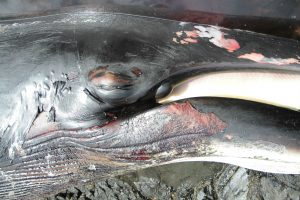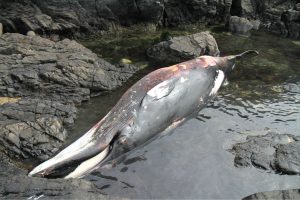SHOCKING images have surfaced showing an “otherwise healthy” whale that died after becoming entangled in fishing rope.
The female minke washed up on a remote part of the Ardnamurchan Peninsula two weeks ago following sightings of a dead whale floating just off the coast of Mull.
Experts took samples from the tragic animal and last week confirmed that the female was most likely to have died after becoming entangled in the fishing line.
They also revealed that the whale was otherwise healthy before she reached her death.
The fishing equipment responsible is thought to have been a piece of creel line which is likely to have been discarded from a fishing boat.
The whale was part of a group of minke whales that had been spotted feeding around the island over recent weeks.
Dr Lauren Hartny-Mills (CORR), Science Officer at Hebridean Whale and Dolphin Trust (HWDT) said: “In this case, the timely reporting of the dead whale, even at sea, enabled us to track its movements, access it when it stranded and determine the cause of death.
“It is crucial that we are aware of these cases, as it helps to help us to understand the different threats that whales face in the Hebrides.”

Dr Andrew Brownlow, veterinary pathologist at Scotland’s Rural College (SRUC) and head of the Scottish Marine Animal Stranding Scheme (SMASS) who conducted tests on the whale, said, “One of the vital aspects of this entanglement project is to encourage creelers to report these cases, rather than just cut them free.
“If we can understand the type of equipment involved in these entanglements, and the way the animal became entangled, we have a better chance of working out sensible mitigation strategies.
“Minimising entanglements in creel lines will reduce both whale mortality and the economic cost to fishermen due to the loss of gear. ”
HWDT and SMASS are part of a new cross sector collaborative project who have been working together to understand and reduce the risk of animals becoming entangled in creel lines, also known as fishing pots.
A heartbreaking image of the whale was posted on the HWDT Facebook page informing followers of the prompting messages from concerned social media users.
Cath Ní wrote: “Utterly heartbreaking. What are we doing to these gentle giants!?”
Sasha Taylor said: “This is just one of the reasons I spend a lot of my time picking up after others.
“I have personally removed many kilograms of abandoned fishing gear from several beaches in several countries, and knowing that they can no longer cause terrible situations like this is reward enough.”
And Patricia Hovey wrote: “Very sad. Sorry to see this.”

A spokesman from The Scottish Creel Fishermen’s Federation said: “Sadly we sometimes encounter animals entangled in fishing gear.
“As an organisation we take this seriously and want to do our best to minimise the risk of this happening and to have advice for what to do in response if and when such incidents do occur.
“We wish to promote working towards methods and practices that best ensure the safety of these animals that we are lucky to work alongside, whilst looking for solutions to potential issues that might arise when we strive to make a living in the same waters that these animals live.”
Surveys in 1994 and 1995 estimated around 110,000 minke whales in the eastern Atlantic – with 8,500 in the North Sea.
However, the International Whaling Commision still believes that minke populations have not recovered from past whaling.
Minke are most often spotted around Scotland between July and September but they can be seen at any time between May and October.
Females can reach up to 8.5m (28ft) in length with males only slightly smaller.
When a minke surfaces from the sea they can be recognised by their long, arched back, and sickle-shaped dorsal fin.

